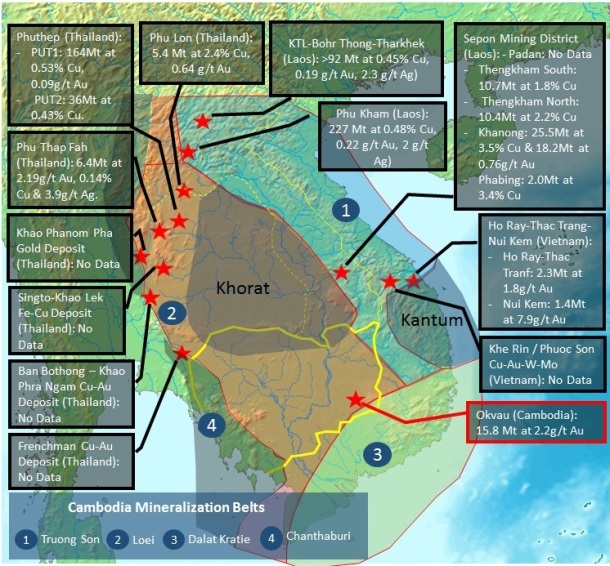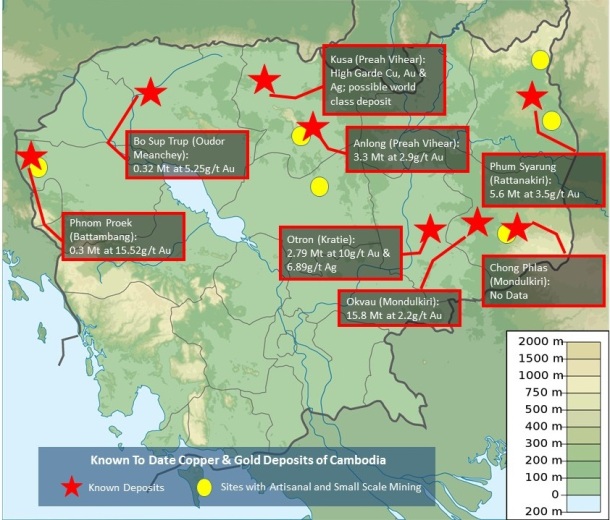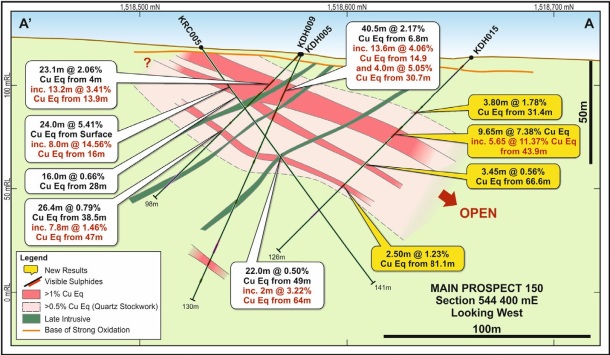Introduction
Since I started to join the Ministry of Mines and Energy in 2013, I kept wondering how rich Cambodia is and what the potential of the country in mineral resources is.
There are reports and results of exploration activities by various companies under exploration licenses from the government, but no one seems to have compiled and conducted an overall economic assessment of geologic potentials and mineral resources at the country level.
This article is just my attempt to build a short new overview of the overall country’s geologic potential and mineral resources, based on results of works and my interactions with experts in this area and exploration companies who currently do exploration works in the country. The main source of this article is the reports produced for me by Nick Franey, an Australian geologist consultant, who was assigned as my adviser during a short period in 2015.
What Are Key Mineral Resources Does Cambodia Have?
This is the first question I asked when trying to understand the country true potentials. Many literature have stated that Cambodia is abundant in mineral resources and many types of mineral are reported. But, after reviewing those documents, I found that those reported are mainly indicative or rather prospective and no further evaluation to determine whether those called mineral occurrences are exploitable resources or not.
Based on current level of study and information, I would make a list of the following key types of minerals as the most important mineral potentials of Cambodia and likely to bear significant impacts on Cambodia future economy:
- Copper and Gold
- Bauxite and
- Oil and Gas
Other types of minerals such as limestone and coal are also found in the country, but its economy seems marginal. For the purpose of this article, only copper and gold will be discussed. Other priority commodities will be discussed in later articles.
What is Cambodia’s Prospectivity in Geologic Potential of Copper and Gold?
Major regional and world class deposits of copper, iron and gold are located along what geologist called mineralization belts. There are four mineralization belts cut through Cambodian terrain (see figure 1):
- Truong Son;
- Loei;
- Dalat-Kratie; and
- Chanthaburi

Figure 1: Mineralization Belts of Cambodia
These four mineralization belts are sources of world class copper, iron and gold deposits found in Laos, Thailand and Vietnam. But yet, its parts located in Cambodia are not explored, although few deposits were already discovered such as Okvau in Mondulkiri province. The prospectivity for those types of deposit that have already been discovered in the region is clear enough, including porphyry-related Cu(-Au) skarns, epithermal Au-Ag, and orogenic Au deposits.
The results of resources assessment by U.S. Geological Survey in the region covering Cambodia has indicated that two geographic areas were delineated as permissive tracts of porphyry copper: a small part of the Sukhothai Tract (142pCu7021) covers the northern parts of Cambodia, while about half of the Mekong Delta Tract (142pCu7023) covers the eastern and southern half of Cambodia (see figure 2).

Figure 2: Permissive Tracts for porphyry copper deposits, SE Asia (Hammarstrom, 2013) / 142pCu7021: Sukhothai Tract; 142pCu7023: Mekong Delta
Even though the Phu Kham porphyry copper-gold deposit and the Sepon copper-gold skarn and carbonate replacement deposits are located in this tract, along with several other copper-gold prospects, the USGS assessment team considered that the Sukhothai Tract is essentially unexplored, partly due to the heavily vegetated and rugged terrain, and partly due to political turmoil and the aftermath of war. They claim that there is a 50% chance of there being eight or more undiscovered porphyry copper deposits in the area, with a combined total copper resource of 24Mt Cu.
There are no known porphyry related copper deposits in the Mekong Delta Tract, and only a few prospects with any signs of copper or gold mineralisation (although the OKvau intrusion-related gold deposit, located in central Mondulkiri, is in this tract). Modern exploration of this tract has only been undertaken over the last decade and much of the area is strongly lateritized, making it difficult for grassroots geochemical surveys; the area is considered to be unexplored. The USGS team estimate that there is an even chance that six or more deposits exist in the tract, with a combined total resource of 16Mt Cu.
Where Are Copper and Gold Deposits Known to Date In Cambodia?
There are many mineral occurrences and prospects indicating possible gold and copper deposits in Cambodia. But to date, the deposits of either gold or copper discovered and likely bearing significant economic impacts are as in the figure 3 below.

Figure 3: Copper and Gold Deposits of Cambodia
Among these deposits, Okvau is the only gold deposit which was very well evaluated and studied. The OKvau deposit is the only ‘JORC-compliant’ mineral resource in Cambodia (15.8Mt at 2.22g/t = 1.1Moz Au). The deposit has Classic Intrusive Related Gold geochemical signature. The potential of Okvau deposit remains ‘open’ along strike and depth. There is a substantial exploration upside, 400km2 of geology prospective for large scale Intrusive Related Gold System. Okvau deposit is explored by Renaissance Minerals (Cambodia) Limited.
Other deposits which were fairly well studied are Phum Syarung Gold Deposit in Rattanakiri province and Kou Sa Copper-Gold Deposit in Chep, Preah Vihear province. The remaining deposits were poorly studied or mainly known by mining activities conducted by local people and, in some cases, mining companies.
Phum Syarung deposit is located in a 12km2 un-explored concession. The gold mineral resources estimate was done based on exploration works over an area of about 1km2 of the total area. The estimated resources is 5.6 Mt at 3.5g/t Au. The deposit is now moving to mining stage by an Indian based mining company, MESCO Gold Cambodia. The company declared a “mineable reserve” of 500,000t ore, with an average thickness of 2.17m and an average grade of 3.29g/t Au.
Kou Sa Copper-Gold Deposit is located in Chep district of Preah Vihear province. The concession is under exploration stage and no official resources estimation was declared yet. But, results from geological surveys and drillings have indicated potential discovery of world class copper and gold deposits. Several mineral prospects of economic grade and tonnage are identified (see figure 4). High grade and near surface copper and gold were discovered by drillings. Metallurgical test indicated also good recoveries: Cu 98%, Au 94% and Ag 91%. The resource and economic assessments are under way in this coming 2016-2017. The exploration on this deposit is operated by Gold Resources Development Co., Ltd. in cooperation with Geopacific Resources Limited.

Figure 4: Kou Sa Prospect 150
Phnom Anlong Gold Deposit in Rovieng, Preah Vihear province. The deposit is known mainly by current intensive mining activities conducted by local people for both placer and rock deposits. Some exploration works were done in the area by company obtaining exploration license from the government. The resources estimation of the deposit declared by this exploration company is 3.3 Mt at 2.9 g/t Au. The mining on this deposit is operated by Cambodia WS Mining Co., Ltd.
Bo Sup Trup gold deposit is located near the boundary of Bateay Meanchey and Oudor Meanchey provinces in district named Ampil. The deposit is gold bearing quartz sulfide veins. The resources estimated of this deposit is 0.32 Mt at 5.52g/t Au. Mining in this deposit is operated by Angkorwat Cement Company Ltd.
Phnom Preuk gold deposit is located in Phnom Proek District, Battambang province. Phnom Preuk is a gold-rich skarn deposit, hosted by Permian limestones within the contact metamorphic aureole of overlying andesitic volcanics (or intrusive?). The resources estimated for this deposit is 0.278 Mt at 15.52g/t Au. The mining on this deposit is operated by Phu Yang (Cambodia) Co. Ltd.
Otron gold deposit is located in Sambo district, Kratie province. The area was previously mined by local people and then mining is operated by a company named Xing Yuan Kanng Yeak Co.Ltd. The resources estimated for this deposit is 2.79 Mt at 10g/t Au.
Chong Phlas gold deposit is located in Keo Seima district, Mondulkiri province. The area is intensively mined by local people. To date, a license is yet to issue to Rong Cheng Industrial (Cambodia) Investment Co.,Ltd., who had previously explored the area and applied for mining license. No information on resources estimated for this deposit is available yet in the the time of this article.
What Would Be Likely Economic Impacts If Those Deposit Are Developed?
Although Cambodia may not be as rich as few other countries in SE Asia in term of mineral resources, there can be no doubt that Cambodia is prospective for copper and gold. Cambodia is also very immature. There is still much work to be done to properly understand the geology and true mineral potential of the country.
Developing these resources will provide for opportunities to create employment and various local economic activities supporting the mining industry. In term of government’s revenue, the mining business will also provide the national revenues through the following collections:
- Royalty – varies depending on type of commodities;
- Corporate Minimum Tax (1%) or Income Tax (30%);
- Additional Resource Tax / Excess Profit Tax: based on R-Factor of the project;
- Export Duty (10%);
- Withholding Taxes on Services, Interest and Dividend repartition; and
- Various Fees: Rental, Community Fund, Environmental Fund, Training Fees, etc.
It would be very interesting to run an estimation of likelihood of government’s revenues if those deposits were developed. To do this requires much more detailed review of all feasibility study reports submitted by the companies together with application for mining licenses, which is beyond the scope of this article. But, I surely will find another appropriate time to do it later in my future article. A sample of this kind of work for a single deposit was already posted in my previous article and can be accessible with this link: how-to-evaluate-governments-fiscal-benefits-of-a-mining-project.